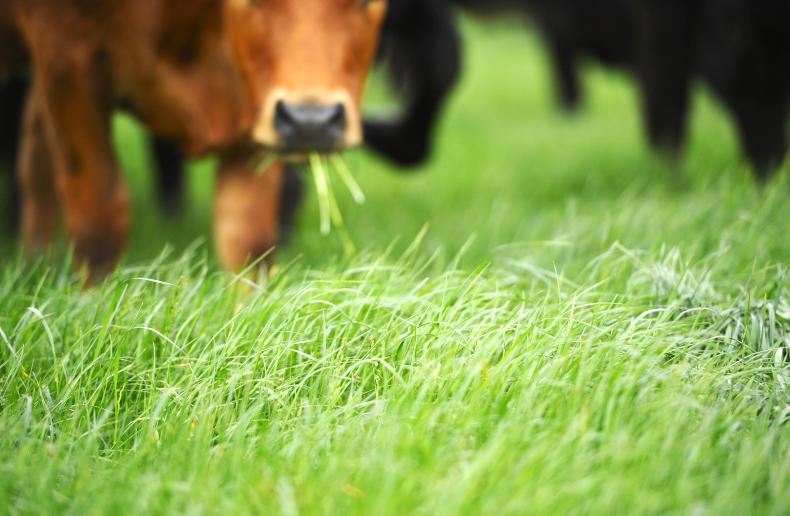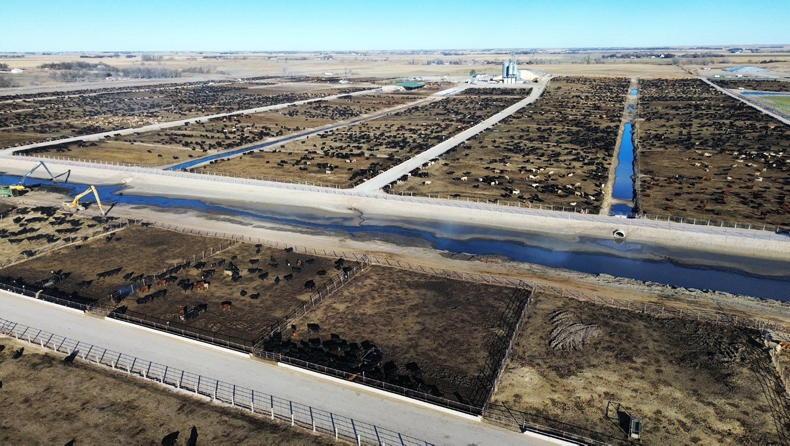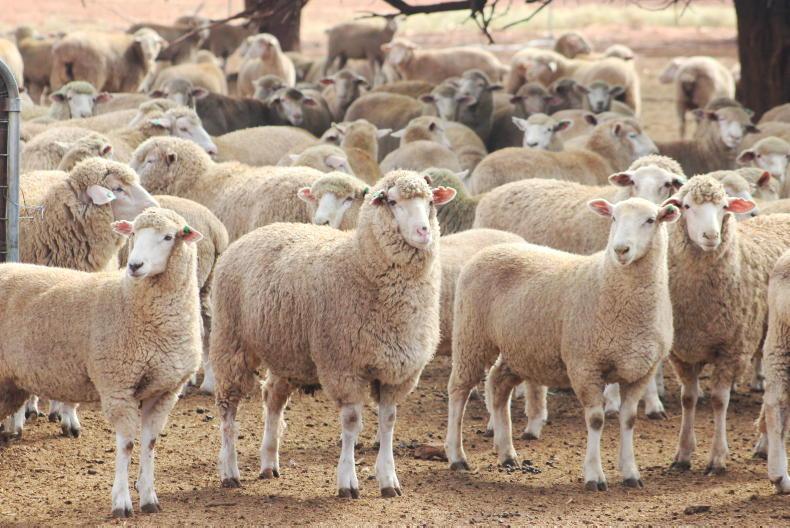There has been a mixed reaction to the rollout of the two beef production standards last week and the rollout of the two together has caused some confusion.
The protected geographical indication (PGI) application for Irish grass-fed beef will afford the industry the opportunity to gain protected status and allow consumers build confidence in the “Irish Grass Fed Beef” PGI brand, and ultimately pay a premium price for it.
Bulls are not included in the application and animals must graze for a minimum of 220 days at pasture and derive at least 90% of their lifetime gain from grass or grass-based forage to qualify.
Standard
Separately, the Bord Bia grass-fed standard is a classification to verify beef as being grass-fed, meaning products from approved animals can carry a grass-fed logo. Bulls are included in the grass-fed standard if they meet the criteria of spending 220 days at pasture in each year of their lifetime and if they derive 90% of their liveweight gain from grazed grass.
Bord Bia on the PGI standard
Irish Farmers Journal (IFJ): The PGI document states that a quality control officer will inspect the beef carcase for beef colour and this, among other criteria, will determine grass-fed PGI eligibility. Will this person be employed by the meat processor?
Bord Bia: A growing amount of importance for PGIs is not just based on product reputation but also the visual and organoleptic properties (the aspects of food that create a unique experience via the senses including taste, sight, smell etc). Having measurable criteria and evidence in this respect is considered very important, which is why the PGI draft specification states that Bord Bia will develop and apply a colour chart that will be used to assess and include carcasses to show the typical ranges of colour for meat and fat. The proposed chart, and the implementation at processing level, is yet to be developed. However, it will be done to international best practice and standards. The aim is to only exclude carcases that are clearly not from a grass-fed system, eg veal.
IFJ: Was the PGI application presented to farmer representatives prior to being drawn up?
BB: The PGI application and process began with an industry workshop with the European Commission in February 2019. Representatives from all of the farm organisations were present. Since then, and throughout the development of the application process, Bord Bia has engaged with farmer representatives through ongoing one-to-one discussions, the beef taskforce and Bord Bia’s board infrastructure. Farmer organisations are represented on our meat and livestock board and also Bord Bia’s main board.
IFJ: Has any impact assessment been undertaken to assess the financial benefit to farmers?
BB: PGI products generally tend to attract a price premium. Analysis of Mintel’s GNPD database across key European markets suggests that meat, dairy and fish products with a PGI logo have attracted a price premium of 10% to 20% over the last five years.
IFJ: Can farmers bring their own cattle to the factory or must they use a licensed haulier? Can farmers bring cattle to a factory outside a two-hour radius from their farm?
BB: Yes, farmers can bring their own cattle to the factory. There is no change in these requirements over the current standard transport requirements in the SBLAS and MPQAS. The application wording (section five) highlighted that low transport times are a feature of Irish beef production, as a result of all producers being located within two hours of an abattoir. There is no stipulation that the journey time must be under two hours.
IFJ: How much extra will be paid for eligible cattle?
BB: As of now there is no PGI status and therefore it is premature to discuss any potential premium. What is clear based on the current position of PGI products in the European market is that they tend to copper-fasten the premium positioning of eligible products. The strength of PGI is that it represents a unique product that differentiates itself in most European markets. The niche status of PGI means that the risk of devaluing ‘mainstream’ products is minimised.
Farm organisation reaction
The IFA and ICSA have reacted angrily to the proposals. ICSA suckler chair Ger O’Brien said: “We believe it makes absolutely no sense to bring in a scheme that would militate against quality continental suckler bull beef. The inclusion of most dairy stock will undermine any chance of a premium price for suckler farmers.”
It is trying to give them even more control over farmers
IFA president Tim Cullinan said: “When PGI was raised at the recent beef taskforce, it was clear that it needed a lot more discussion. The only party that was completely in favour of Bord Bia’s concept was Meat Industry Ireland (MII).
“The detail behind this proposal has been driven by MII and the factories. It is trying to give them even more control over farmers,” he said.
As far as Cullinan is concerned, farmers need to be at the heart of the process. “Any benefit in the market place must accrue to farmers as we are the ones who are creating the value by grass-feeding our animals,” he said.
There has been a mixed reaction to the rollout of the two beef production standards last week and the rollout of the two together has caused some confusion.
The protected geographical indication (PGI) application for Irish grass-fed beef will afford the industry the opportunity to gain protected status and allow consumers build confidence in the “Irish Grass Fed Beef” PGI brand, and ultimately pay a premium price for it.
Bulls are not included in the application and animals must graze for a minimum of 220 days at pasture and derive at least 90% of their lifetime gain from grass or grass-based forage to qualify.
Standard
Separately, the Bord Bia grass-fed standard is a classification to verify beef as being grass-fed, meaning products from approved animals can carry a grass-fed logo. Bulls are included in the grass-fed standard if they meet the criteria of spending 220 days at pasture in each year of their lifetime and if they derive 90% of their liveweight gain from grazed grass.
Bord Bia on the PGI standard
Irish Farmers Journal (IFJ): The PGI document states that a quality control officer will inspect the beef carcase for beef colour and this, among other criteria, will determine grass-fed PGI eligibility. Will this person be employed by the meat processor?
Bord Bia: A growing amount of importance for PGIs is not just based on product reputation but also the visual and organoleptic properties (the aspects of food that create a unique experience via the senses including taste, sight, smell etc). Having measurable criteria and evidence in this respect is considered very important, which is why the PGI draft specification states that Bord Bia will develop and apply a colour chart that will be used to assess and include carcasses to show the typical ranges of colour for meat and fat. The proposed chart, and the implementation at processing level, is yet to be developed. However, it will be done to international best practice and standards. The aim is to only exclude carcases that are clearly not from a grass-fed system, eg veal.
IFJ: Was the PGI application presented to farmer representatives prior to being drawn up?
BB: The PGI application and process began with an industry workshop with the European Commission in February 2019. Representatives from all of the farm organisations were present. Since then, and throughout the development of the application process, Bord Bia has engaged with farmer representatives through ongoing one-to-one discussions, the beef taskforce and Bord Bia’s board infrastructure. Farmer organisations are represented on our meat and livestock board and also Bord Bia’s main board.
IFJ: Has any impact assessment been undertaken to assess the financial benefit to farmers?
BB: PGI products generally tend to attract a price premium. Analysis of Mintel’s GNPD database across key European markets suggests that meat, dairy and fish products with a PGI logo have attracted a price premium of 10% to 20% over the last five years.
IFJ: Can farmers bring their own cattle to the factory or must they use a licensed haulier? Can farmers bring cattle to a factory outside a two-hour radius from their farm?
BB: Yes, farmers can bring their own cattle to the factory. There is no change in these requirements over the current standard transport requirements in the SBLAS and MPQAS. The application wording (section five) highlighted that low transport times are a feature of Irish beef production, as a result of all producers being located within two hours of an abattoir. There is no stipulation that the journey time must be under two hours.
IFJ: How much extra will be paid for eligible cattle?
BB: As of now there is no PGI status and therefore it is premature to discuss any potential premium. What is clear based on the current position of PGI products in the European market is that they tend to copper-fasten the premium positioning of eligible products. The strength of PGI is that it represents a unique product that differentiates itself in most European markets. The niche status of PGI means that the risk of devaluing ‘mainstream’ products is minimised.
Farm organisation reaction
The IFA and ICSA have reacted angrily to the proposals. ICSA suckler chair Ger O’Brien said: “We believe it makes absolutely no sense to bring in a scheme that would militate against quality continental suckler bull beef. The inclusion of most dairy stock will undermine any chance of a premium price for suckler farmers.”
It is trying to give them even more control over farmers
IFA president Tim Cullinan said: “When PGI was raised at the recent beef taskforce, it was clear that it needed a lot more discussion. The only party that was completely in favour of Bord Bia’s concept was Meat Industry Ireland (MII).
“The detail behind this proposal has been driven by MII and the factories. It is trying to give them even more control over farmers,” he said.
As far as Cullinan is concerned, farmers need to be at the heart of the process. “Any benefit in the market place must accrue to farmers as we are the ones who are creating the value by grass-feeding our animals,” he said.










SHARING OPTIONS